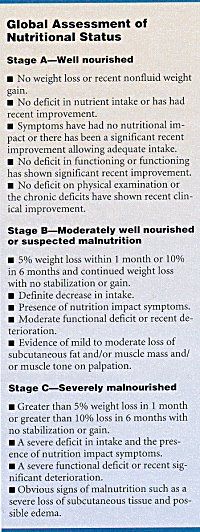PG-SGA, Latest Advance in Assessing Nutritional Status
PHILADELPHIA-Over the last 20 years, nutritional assessments in oncology have evolved from just assessing a patient’s nutritional status to using the information to improve outcome. The latest assessment tool is the scored Patient Generated Subjective Global Assessment (PG-SGA) developed by Faith Ottery, MD, PhD, president of the Society for Nutritional Oncology Adjuvant Therapy.
PHILADELPHIAOver the last 20 years, nutritional assessments in oncology have evolved from just assessing a patients nutritional status to using the information to improve outcome. The latest assessment tool is the scored Patient Generated Subjective Global Assessment (PG-SGA) developed by Faith Ottery, MD, PhD, president of the Society for Nutritional Oncology Adjuvant Therapy.
The PG-SGA was discussed at a session of the 5th Annual Congress of the Society for Nutritional Oncology Adjuvant Therapy.
Even though this is called a subjective global assessment, it has great reliability, said Suzanne Kasenic, RD, an oncology dietitian at Temple University Cancer Center, Philadelphia. Ms. Kasenic worked with Dr. Ottery to develop the point system by which the PG-SGA is scored.
The PG-SGA is the latest step in an evolution that began in the 1980s when Detsky and Baker first showed that the results of clinical assessment of nutritional status correlated with results of assessments using laboratory tests and anthropometric measures, and that the major factor clinicians use to determine overall nutritional status is loss of subcutaneous tissue, muscle, and weight.
The first SGA was developed and published by the University of Toronto in 1987. Dr. Otterys PG-SGA includes a numeric score for triage of medical nutrition therapy and a global assessment rating.
Numeric Score
The total numeric score is derived from information supplied by the patient and the clinician. Patients enter information on a form about their weight, dietary intake, the nutritional impact of their symptoms, and their functioning. The clinician supplies information about the patients disease and its metabolic and physical demands.

The score is keyed to broad categories of nutritional triage recommendations, which include patient and family education and symptom management, including pharmacologic intervention and appropriate nutrient intervention (food, nutritional supplements, enteral or parenteral nutrition).
The clinicians global assessment of nutritional status is based on the history and a physical examination, and is assigned a letter, from A (well nourished) to C (severely malnourished) (see Table, left).
The global assessment is a broader assessment that takes a longer view and is reflective of what happens with a patient over a longer period of time, Ms. Kasenic said. It connotes a physiological state. So if the patient is assigned an A classification, were saying that the person is probably in an anabolic state, whereas if they are labeled C, the understanding is that it is a catabolic state. The total numeric score gives more of a snapshot, a freeze-frame of where that patient is at a particular time.
Interventions are tied to the numeric score, not to the global score, Ms. Kasenic stressed. The idea is that, hopefully, in intervening in reaction to patients numeric scores, you will eventually change their global rating and begin to move them in the direction we want them to go.
Using the PG-SGA in Clinical Trials
Ms. Kasenic said that the scoring also makes it possible to relate the PG-SGA rating to scales that are already recognized in clinical practice such as performance scales and toxicity scales.
We would like to see nutrition begin to be incorporated into clinical trials, into protocols that are funded by the NCI, she said. With those protocols, there are always toxicity scales that tell the oncologists at what point they must reduce the dosage of the drug or stop the study or intervene in some wayand we would like to see nutrition be a stronger part of the scales. There is already a toxicity scale for weight loss in these studies.
Newsletter
Stay up to date on recent advances in the multidisciplinary approach to cancer.
Elevating the Quality of Cancer Care via Cross-Department Collaboration
Experts from Sibley Memorial Hospital discuss how multidisciplinary work has enhanced outcomes such as survival and resource use at their institution.